|
Glossary of Computer Terms
Adware - software that transfers aggregated usage information, collected to deliver to you advertisements that are especially tailored to your internet browsing habits. Application - Computer software that performs a task or set of tasks, such as word processing or drawing. Applications are also referred to as programs. ASCII - American Standard Code for Information Interchange, an encoding system
for converting keyboard characters and instructions into the binary number code that the computer
understands. BIOS - Binary Input Output System - the firmware code run by a personal computer when first powered on which identifies and initiates component hardware (such as hard disk, floppy and optical disk drives) so software programs can load, execute, and assume control of the PC. Bit - (short for “binary digit”). The smallest piece of computer information, either the number 0 or 1. Boot - To start up a computer. Cold boot—restarting computer after having turned off the power. Warm (or soft) boot—restarting computer without having turned off the power. Browser - Software used to access and navigate the Internet. Microsoft Internet Explorer, Mozilla Firefox and Netscape are today's most popular browsers. Bug - A malfunction due to an error in the program or a defect in the equipment. Byte - Most computers use combinations of eight bits, called bytes, to represent one character of data or instructions. For example, the word “pen” has three characters, and it would be represented by three bytes. Cookie - A text file sent by a Web server that is stored on the hard drive of a computer which may be used to relay back to the Web server information about the user, computer, and computer activities. Cookies are used all over the internet in useful and less useful places. Advertisement companies often set cookies whenever your browser loads a banner from them in order to learn about sites you visit that contains their ads. CPU - Central Processing Unit. The brain of the computer. Database - A collection of similar information stored in a file, such as a database of addresses. This information may be created and stored in a database management system (DBMS). Desktop - 1) The main screen of the user interface in a window based environment. Desktops usually contain icons that represent links to frequently used programs,the hard drive, a network (if there is one), and a trash or recycling bin for files to be deleted. 2) A non-portable personal computer. Desktop publishing - The production of publication-quality documents using a personal computer in combination with text, graphics, and page layout programs. Device driver - is a specialized computer program allowing higher-level computer programs to interact with a computer hardware device. Device drivers are both hardware and operating-system specific, and are often supplied by the manufacture of the computer hardware device, such as a printer, video card, LAN card or modem. DHCP - Dynamic Host Configuration Protocol - The protocol of a server that manages dynamically assigned IP addresses. Directory - A list of files stored in the computer. Domain - In Windows, a logical group of networked computers, such as within a business organization, that share a centralized directory database. Domain name - A unique text-based name that identifies the IP address of a network or computer linked to the Internet. Each domain name ends with a suffix that indicates what “top level domain” it belongs to. These include: “.com” for commercial, “.gov” for government, “.org” for organization, “.edu” for educational institution, “.biz” for business, “.info” for information, “.tv” for television, “.ws” for website. Domain suffixes may also indicate the country in which the domain is registered. DNS - Domain Name System or Domain Name Service - a database on a top-level domain name server that keeps track of assigned domain names and their corresponding IP addresses. DOS - Disk Operating System. An operating system designed for early IBM-compatible PCs. DSL - Digital Subscriber Line. (and ADSL - asymmetric digital subscriber line) A method of connecting to the Internet via a phone line. A DSL connection uses copper telephone lines but is able to relay data at much higher speeds than modems and does not interfere with telephone use. DVD - Digital Video Disc - a popular optical disc storage media format. Its main uses are video and data storage. Most DVD's are of the same dimensions as compact discs (CDs) but store more than 6 times as much data. Email - Electronic mail; messages, including memos or letters, sent electronically between networked computers that may be across the office or around the world. Encryption - The process of transmitting scrambled data so that only authorized recipients can unscramble it. For instance, encryption is used to scramble credit card information when purchases are made over the Internet. EPROM - Erasable Programmable Read-Only Memory - is a type of computer memory chip that retains its data when its power supply is switched off.
Firewall - a type of software or hardware that controls data transfers. A firewall is typically used to secure the access to a computer or a network from another network (which may be the internet). A hardware firewall is simply a box that is put between the local and the far network and that allows or denies transfers based on predefined rules; a software firewall is a program on a computer which basically does the same thing. Firewire - Apple® Computer's high-speed data transfer. Frequently used to import video to a computer. Firmware - a computer program that is embedded in a hardware device, for example a microcontroller. FTP - File Transfer Protocol. A format and set of rules for transferring files from a host to a remote computer. Gigabyte (GB) - 1024 megabytes. Also called gig. GUI - Graphical User Interface. A system that simplifies selecting computer commands by enabling the user to point to symbols or illustrations (called icons) on the computer screen with a mouse. HTML - Hypertext Markup Language. A standard of text markup conventions used for documents on the World Wide Web. Browsers interpret the codes to give the text structure and formatting (such as bold, blue, or italic) and hypertext. XHTML, or Extensible HyperText Markup Language, conforms to XML syntax standards and is the proposed successor to HTML. HTTP - Hypertext Transfer Protocol. A common system used to request and send HTML documents on the World Wide Web. It is the first portion of all URL addresses on the World Wide Web (e.g., http://www.digitalnetexpress.com). HTTPS - Hypertext Transfer Protocol Secure. Often used in intra company internet sites. Passwords are required to gain access. Hyperlink - Text or an image that is connected by hypertext coding to a different location. By selecting the text or image with a mouse, the computer “jumps to” (or displays) the linked text. Hypertext - A system for organizing text through links, as opposed to a menu-driven hierarchy such as Gopher. Most Web pages include hypertext links to other pages at that site, or to other sites on the World Wide Web. Icons - Symbols or illustrations appearing on the computer screen that indicate program files or other computer functions. IDE - Integrated Device Electronics - A type of hard drive whose controller is integrated into the drive. Input device - A device, such as a keyboard, stylus and tablet, mouse, scanner, or microphone, that allows input of information (letters, numbers, sound, video) to a computer. IM - instant messaging - A chat application that allows two or more people to communicate over the Internet via real-time keyed-in messages. Interface - The interconnections that allow a device, a program, or a person to interact. Hardware interfaces are the cables that connect the device to its power source and to other devices. Software interfaces allow the program to communicate with other programs (such as the operating system), and user interfaces allow the user to communicate with the program (e.g., via mouse, menu commands, icons, voice commands, etc.). Internet - An international conglomeration of interconnected computer networks. Begun in the late 1960s, it was developed in the 1970s to allow government and university researchers to share information. The Internet is not controlled by any single group or organization. Its original focus was research and communications, but it continues to expand, offering a wide array of resources for business and home users. IP (Internet Protocol) address - a unique 32-bit string of four numbers separated
by periods used to identify computer on a network. Each number can be from 0 to 255 (i.e., 192.168.10.166).
IP addresses of web servers must be registered to avoid duplicates. Other IP address can be permanently
assigned by an administrator or assigned dynamically by a DHCP server. JPEG - A popular format for compressing, or reducing the size, of photographs. The name JPEG stands for Joint Photographic Experts Group, the name of the committee that created the standard during the early 1990's. The most common filename extensions for files employing JPEG compression are .jpg and .jpeg. The JPEG standard, ISO 10918-1, specifies both the codec, which defines how an image is compressed into a stream of bytes and decompressed back into an image, and the file format used to contain that stream. Kilobyte (K or KB) - Equal to 1,024 bytes. LAN - Local Area Network - a network located within a small area or common environment such as an office or building. Laptop or notebook - Small, lightweight, portable battery-powered computers
that can fit onto your lap. They each have a thin, flat, display screen. Megabyte (MB) - Equal to 1,048,576 bytes, usually rounded off to one million bytes (also called a “meg”). Menu - A context-related list of options that users can choose from. Merge - To combine two or more files into a single file. MHz - An abbreviation for Megahertz, or one million hertz. One MHz represents one million clock cycles per second and is the measure of a computer microprocessor's speed. For example, a microprocessor that runs at 300 MHz executes 300 million cycles per second. Each instruction a computer receives takes a fixed number of clock cycles to carry out, therefore the more cycles a computer can execute per second, the faster its programs run. Megahertz is also a unit of measure for bandwidth. Microcontroller - is a type of microprocessor emphasizing high integration, low power consumption, self-sufficiency and cost-effectiveness, in contrast to a general-purpose microprocessor (the kind used in a PC). Microcontrollers are frequently used in automatically controlled products and devices, such as automobile engine control systems, remote controls, office machines, appliances, power tools, and toys. Modem - A device that connects two computers together over a standard telephone or cable line by converting the computer's data into an audio signal. Modem is a contraction for the process it performs: modulate-demodulate. Monitor - A video display device which uses either liquid crystal display (LCD) or cathode ray tube (CRT) technology. Because of their slimmer design and lower energy consumption, monitors using LCD technology (also called flat panel or flat screen displays) are replacing the venerable CRT on most desktops. Moore's Law - Intel co-founder Gordon E. Moore described an important trend in the history of computer hardware, that the number of transistors that can be inexpensively placed on an integrated circuit is increasing exponentially, doubling approximately every two years.
Mouse - A small hand-held device, similar to a trackball, used to control the position of the cursor on the video display; movements of the mouse on a desktop correspond to movements of the cursor on the screen. MPEG - A popular format for compressing, or reducing the size, of moving pictures. The name stands for Moving Picture Experts Group, the name of the committee that created the standard during the early 1990's. MPEG has standardized the following compression formats and ancillary standards:
MP3 - MPEG-1 Audio Layer 3, compact audio file format. The small size of the files makes them easy to download and e-mail. Format used in portable playback devices. Multimedia - Software programs that combine text and graphics with sound, video, and animation. A multimedia PC contains the hardware to support these capabilities. Network - A group of interconnected computers that can communicate with each other to share information or peripherals, such as printers. NIC - Network Interface Card - a network adapter board which provides a port to connect the PC to a network. Open source - Computer programs whose original source code was revealed to the general public so that it could be developed openly. Software licensed as open source can be freely changed or adapted to new uses. Programmers may redistribute and modify the code, as long as they don't collect royalties on their work or deny access to their code. Since development is not restricted, more programmers can debug and improve the source code faster. Operating system - A set of instructions that tell a computer on how to operate when it is turned on. It sets up a filing system to store files and tells the computer how to display information on a video display. Popular computer operating systems include Windows, UNIX, Linux, and Macintosh OS.
PDF - Portable Document Format. A format presented by Adobe Acrobat® that allows documents to be shared over a variety of operating systems. Documents can contain words and pictures and be formatted to have electronic links to other parts of the document or to places on the web. Peripheral - Any external device attached to a computer to enhance operation. Examples include external hard drive, scanner, printer, speakers, keyboard, mouse, trackball, stylus and tablet, and joystick. Program - A precise series of instructions written in a computer language that tells the computer what to do and how to do it. Programs are also called “software” or “applications.” Programming language - A series of instructions written by a programmer according to a given set of rules or conventions (“syntax”). Programming language instructions are converted into programs in language specific to a particular machine or operating system (“machine language”) so that the computer can interpret and carry out the instructions. Some common programming languages are BASIC, C, C++, dBASE, FORTRAN, and Perl. Push technology - Internet tool that delivers specific information directly to a user's desktop, eliminating the need to surf for it. PointCast, which delivers news in user-defined categories, is a popular example of this technology. RAID - Redundant Array of Inexpensive Disks. A method of spreading information across several disks set up to act as a unit, using two different techniques:
RAM - Random Access Memory. One of two basic types of memory. Portions of programs are stored in RAM when the program is launched so that the program will run faster. Though a PC has a fixed amount of RAM, only portions of it will be accessed by the computer at any given time. Also called memory. Resolution - refers to the number of individual dots of color, known as pixels, contained on a display. Resolution is expressed by identifying the number of pixels on the horizontal axis (rows) and the number on the vertical axis (columns), such as 800x600 or 1024x768. ROM - Read-Only Memory. One of two basic types of memory. ROM contains only permanent information put there by the manufacturer. Information in ROM cannot be altered, nor can the memory be dynamically allocated by the computer or its operator.
Scanner - An electronic device that uses light-sensing equipment to scan paper images such as text, photos, and illustrations and translate the images into signals that the computer can then store, modify, or distribute. SCSI - Small Computer System Interface - a fast system level interface with a host adapter that can daisy-chain up to 7 or 15 devices. Search engine - Software that makes it possible to look for and retrieve material on the Internet, particularly the Web. Some popular search engines are Alta Vista, Google, HotBot, Yahoo!, Web Crawler, and Lycos. Shareware - Software created by people who are willing to sell it at low cost or no cost for the gratification of sharing. It may be freestanding software, or it may add functionality to existing software. Software - Computer programs that perform a task or group of tasks on a computer, including application software such as word processors which perform productive tasks for users, and system software such as operating systems, which interface with computer hardware to provide the necessary services. Spam - Unsolicited commercial e-mail. Spider - A process search engines use to investigate new pages on a web site and collect the information that needs to be put in their indices. Spreadsheet - Software that allows one to calculate numbers in a format that is similar to pages in a conventional ledger. Microsoft Excel is a popular spreadsheet program. Spyware - software that transmits personally identifiable information from your computer to some place in the internet without your explicit approval, typically used to deliver to you advertisements that are especially tailored to your internet browsing habits. Storage - Devices used to store massive amounts of information so that it can be readily retrieved. Devices include hard disks, RAIDs, CD-ROMs, DVD's Streaming - Taking packets of information (sound or visual) from the Internet and storing it in temporary files to allow it to play in continuous flow. Surge protector - A controller to protect the computer against potentially damaging power voltage surges . Terabytes (TB) - A thousand gigabytes. UNIX® - A very powerful operating system used as the basis of many high-end computer applications. URL - Uniform Resource Locator. 1) The protocol for identifying a document on the Web. 2)A Web address (e.g., http://www.railswest.com). A URL is unique to each user. See also domain. UPC - Universal Product Code. UPC Codes are unique for each item and are widely used in retail stores in the United States for tracking merchandise from the time shipments are received to the time an item is sold. Read more about UPC. UPS - Uninterruptible Power Supply. An electrical power supply that includes a battery to provide enough power to a computer during an outage to back-up data and properly shut down. USB - Universal Serial Bus. An industry standard for connecting different compatible peripheral devices across multiple platforms. Devices include printers, digital cameras, scanners, game pads, joysticks, keyboards and mice, and storage devices. USB peripherals offer the use of plug-and-play convenience by eliminating the need to turn off or restart the computer when attaching a new peripheral. USB supports simultaneous connection of up to 127 devices through interconnected external hubs. Virtual Reality (VR) - A technology that allows one to experience and interact with images in a simulated three-dimensional environment. For example, you could design a room in a house on your computer and actually feel that you are walking around in it even though it was never built. Virus - An unauthorized piece of computer code attached to a computer program or portions of a computer system that secretly copies itself from one computer to another by shared discs and over telephone and cable lines. It can destroy information stored on the computer, and in extreme cases, can destroy operability. Computers can be protected from viruses if the operator utilizes good virus prevention software and keeps the virus definitions up to date. Most viruses are not programmed to spread themselves. They have to be sent to another computer by e-mail, sharing, or applications. The worm is an exception, because it is programmed to replicate itself by sending copies to other computers listed in the e-mail address book in the computer. There are many kinds of viruses, for example:
WAN - Wide Area Network - a network that communicates over long distances such as across a city or around the world. A Local Area Network may become part of a WAN when it is linked to it. Webcam - A video camera/computer setup that takes live images and sends them to a Web browser. Wireless LAN - A network in which computers are connected to a shared access point using radio frequencies. The most common standards are:
Window - A portion of a computer display used in a graphical interface that enables users to select commands by pointing to illustrations or symbols with a mouse. “Windows” is also the name Microsoft adopted for its popular operating system. Windows Media Audio (WMA) is an audio data compression technology developed by Microsoft. The name can be used to refer to its audio file format or its audio codecs. It is a proprietary technology which forms part of the Windows Media framework. WMA is one of the most popular audio codecs. Windows Media Video (WMV) is a compressed video file format for several proprietary codecs, originally developed by Microsoft for Internet streaming applications. In 2003, Microsoft drafted a video codec specification based on its WMV 9 codec and submitted it to the Society of Motion Picture and Television Engineers (SMPTE) for standardization, which was officially approved in March 2006 as SMPTE 421M, better known as VC-1, making the WMV 9 codec an open but still proprietary standard. Since then, VC-1 has become one of the three mandatory video codecs for the Blu-ray Disc and HD DVD-ROM specifications. Workstation - A personal computer connected to a network used to perform tasks through application programs or utilities. Word Processor - A computer system or program for setting, editing, revising, correcting, storing, and printing text. Microsoft Word and Word Perfect are both popular word processor programs. World Wide Web (“WWW” or “the Web”) - A network of servers on the Internet that use hypertext-linked databases and files. It was developed in 1989 by Tim Berners-Lee, a British computer scientist, and is now the primary platform of the Internet. The feature that distinguishes the Web from other Internet applications is its ability to display graphics in addition to text. WYSIWYG - What You See Is What You Get. When using most word processors, page layout programs (See desktop publishing), and web page design programs, words and images will be displayed on the monitor as they will look on the printed page or web page. XHTML - Extensible HyperText Markup Language, is a reformulation of HTML in XML (Extensible Markup Language) and is the proposed successor to HTML as the standard of text markup conventions used for documents on the World Wide Web. XHTML 1.0 became a World Wide Web Consortium (W3C) Recommendation in January 2000. XML - Extensible Markup Language - is a general-purpose markup language which allows its users to define their own elements. Its primary purpose is to facilitate the sharing of structured data across different information systems, particularly via the Internet. ZIP - A popular compression and archival file format. A ZIP file contains one or more files that have been compressed, to reduce their file size, or stored as-is. The format was originally developed by Phil Katz for PKWARE's PKZIP during the late 1980's. Other utilities also support the format including WinZip (Microsoft Windows), Microsoft "compressed folders" and BOMArchiveHelper (Mac OS X).
|

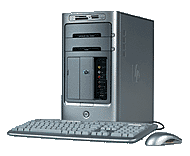 Active Directory - a directory service by Microsoft that provides central authentication and authorization services for Windows based computers,
and allows administrators to assign policies, deploy software, and apply critical updates to an organization.
Active Directory - a directory service by Microsoft that provides central authentication and authorization services for Windows based computers,
and allows administrators to assign policies, deploy software, and apply critical updates to an organization. Disk
- The most common type of media used for storing information in a computer, it is flat and spins
around. Hard disks, also knows as hard drives, are housed inside the computer and can store up to several hundred gigabytes
of information. Removable disks include 3.5" floppy disks which typically store 1.44 megabytes
of data, Zip discs which can store 100 or 250 megabytes of data, CD-ROMs and DVD's.
Disk
- The most common type of media used for storing information in a computer, it is flat and spins
around. Hard disks, also knows as hard drives, are housed inside the computer and can store up to several hundred gigabytes
of information. Removable disks include 3.5" floppy disks which typically store 1.44 megabytes
of data, Zip discs which can store 100 or 250 megabytes of data, CD-ROMs and DVD's.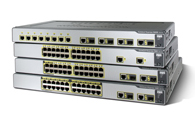 Ethernet
- the most popular type of network topology used to connect computers on a Local Area Network,
typically connecting a computer to a network hub or switch using cable that contains 4 twisted
pairs of wires.
Ethernet
- the most popular type of network topology used to connect computers on a Local Area Network,
typically connecting a computer to a network hub or switch using cable that contains 4 twisted
pairs of wires. Memory - Physical microchips that can temporarily store programs and data.
The information must be stored to a permanent device, such as a hard disc or CD-ROM before the
power is turned off, or the information will be lost.
Memory - Physical microchips that can temporarily store programs and data.
The information must be stored to a permanent device, such as a hard disc or CD-ROM before the
power is turned off, or the information will be lost.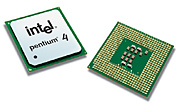 Microprocessor
- A complete central processing unit (CPU) contained on a single silicon chip.
Microprocessor
- A complete central processing unit (CPU) contained on a single silicon chip.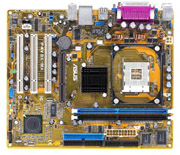 Motherboard
- The main system board inside a computer.
Motherboard
- The main system board inside a computer.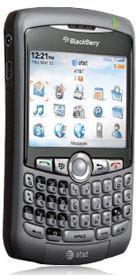 PDA - Personal Digital Assistant. A hand-held computer that can store daily
appointments, phone numbers, addresses, and other important information. Most PDA's link to a
desktop or laptop computer to download or upload information. Popular PDA's include the Palm,
Blackberry and Trio.
PDA - Personal Digital Assistant. A hand-held computer that can store daily
appointments, phone numbers, addresses, and other important information. Most PDA's link to a
desktop or laptop computer to download or upload information. Popular PDA's include the Palm,
Blackberry and Trio. Router - a device that connects networks and transfers a packet of data when
it is addressed to a computer on a connecting network.
Router - a device that connects networks and transfers a packet of data when
it is addressed to a computer on a connecting network. Server
- A computer that shares its programs and data resources and information with other computers,
called clients, on a network.
Server
- A computer that shares its programs and data resources and information with other computers,
called clients, on a network.
